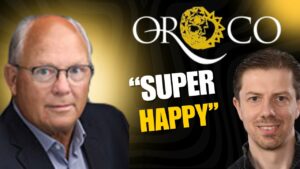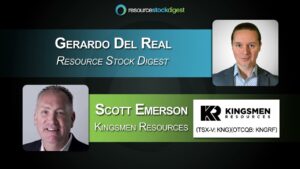Agnico-Eagle (AEM) is a Toronto based Gold producer with operating mines in North America and Finland. Formed in 1972 from the merger of Agnico Mines and Eagle Gold Mines, Agnico-Eagle is focused on a strategy of acquiring and developing quality projects in low risk regions of the world.
4th quarter 2010 sales were $439 million, an increase of 94.5% over the $225.6 million in the 4th quarter of 2009. Net income was $0.53 per share, an increase of 71% over the $0.31 reported in the 4th quarter of 2009. The 53 cents figure includes a loss of $0.04 per share from a combination of stock options, gain on the sale of investments, and foreign currency translation losses.
For the full year 2010 EPS was $2.05 per share compared with $0.55 per share in 2009. Sales were $1.422 billion in 2010 an increase of 131.7% over $613.8 million in sales over 2009.
Despite the falling dollar mine cash costs held steady at $451/share for 2010 while gold reserves rose by 2.9 million ounces to 21.3 million ounces, Proven & Probable (P&P) with 16.2 million ounces Measured, Indicated, and Inferred (MII).
Silver reserves total 123.5 million ounces P&P and 46.8 MII.
Full year gold production was 1.2% below guidance, though up more than 50% year-over-year, due to a slower than expected ramp-up at Meadowbrook as the mine is taking longer than expected to achieve full production and lower than expected grades at Lapa and LaRonde.
There are currently six operating mines in Agnico-Eagles portfolio with $142 million allocated to additional drilling on the properties to expand the current mineralization and further refine the resources.
The Kittila Mine in Finland had higher costs in 2010 due to higher than expected costs with the startup phase of the mine, which should decline into 2011. Gold production is expected to be 150,000 ounces in 2011 over 126,000 ounces in 2010 and 72,000 ounces in 2009.
Kittila will see an additional 56,000 meters of drilling to further refine the resource. Gold mineralization extends 1.4 kilometers down, 300 meters below the current resource, while remaining open at depth and along strike.
Goldex production improved to 184,000 ounces in 2010 over 149,000 ounces in 2009 due to better ore grades and more efficient production. Cash costs at Goldex fell from $366 to $335 per ounce. Production for 2011 is expected to be flat over 2010.
The Goldex mine will see additional drilling located directly below the area being mined. There is potential to see the mineralization expanded with a new deposit in the area below the current deposit.
LaRondes production in 2011 is expected to be about 157,000 ounces, a drop from 2010s production of 162,800 ounces of gold due to lower ore grades being mined until a new internal shaft is completed later in the year. After 2011, production is expected to ramp up to 338,000 ounces of gold per year as higher grades are accessed.
LaRonde will see an additional 42,000 meters of drilling in 2011 to further infill and expand the deposit.
Lapas 2011 production in the LaRonde camp is expected to be 125,000 ounces of gold, slightly higher than the 117,000 ounces mined in 2010.
Meadowbrook achieved commercial production in 2010 with 265,600 ounces of gold produced at a total cash cost of $693 per ounce. Production for 2011 is expected to be 362,000 ounces of gold with production costs falling as throughput increases.
The Meadowbrook Mine will see an additional 32,000 meters of drilling both on-site and regional to expand the Goose deposit and further explore the Vault area.
On the exploration front, approximately 6500 meters will be drilled at the Jennings block in Yukon and the Ester Dome region of Alaska.
Agnico-Eagle holds good value for those investors wishing to avoid mining companies with deposits in risky jurisdictions. With major production assets in North American and Finland investors have little worry about political risk. Capex is falling as major investments are behind Agnico-Eagle for the time being providing a tailwind for investors as Agnico-Eagle builds upon last years explosion in profits.
Disclaimer: Communications are intended solely for informational purposes. Statements made should not be construed as an endorsement, either expressed or implied. This article and the author is not responsible for typographic errors or other inaccuracies in the content. This article may not be reproduced without credit or permission from the author. We believe the information contained herein to be accurate and reliable. However, errors may occasionally occur. Therefore, all information and materials are provided AS IS without any warranty of any kind. Past results are not indicative of future results.
PAST RESULTS ARE NOT INDICATIVE OF FUTURE RESULTS. THERE IS RISK OF LOSS AS WELL AS THE OPPORTUNITY FOR GAIN WHEN INVESTING IN THE STOCK, BOND, AND DERIVATIVE MARKETS. WHEN CONSIDERING ANY TYPE OF INVESTMENT, INCLUDING HEDGE FUNDS, YOU SHOULD CONSIDER VARIOUS RISKS INCLUDING THE FACT THAT SOME PRODUCTS: OFTEN ENGAGE IN LEVERAGING AND OTHER SPECULATIVE INVESTMENT PRACTICES THAT MAY INCREASE THE RISK OF INVESTMENT LOSS, CAN BE ILLIQUID, ARE NOT REQUIRED TO PROVIDE PERIODIC PRICING OR VALUATION INFORMATION TO INVESTORS, MAY INVOLVE COMPLEX TAX STRUCTURES AND DELAYS IN DISTRIBUTING IMPORTANT TAX INFORMATION, ARE NOT SUBJECT TO THE SAME REGULATORY REQUIREMENTS AS MUTUAL FUNDS, OFTEN CHARGE HIGH FEES, AND IN MANY CASES THE UNDERLYING INVESTMENTS ARE NOT TRANSPARENT AND ARE KNOWN ONLY TO THE INVESTMENT MANAGER.
Before making any type of investment, one should consult with an investment professional to consider whether the investment is appropriate for the individuals risk profile. This is not intended to be investment advice or a solicitation to purchase any of the securities listed here. I will not be held liable or responsible for any losses or damages, monetary or otherwise that result from the content of this article.

















